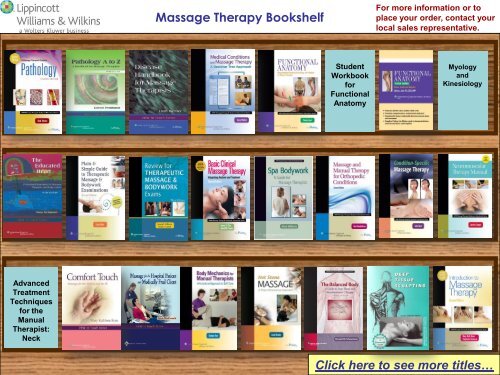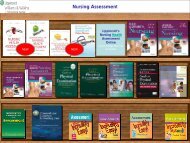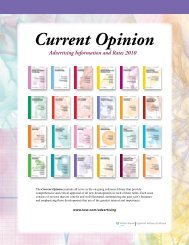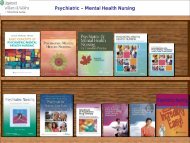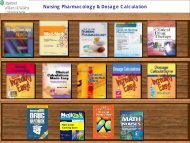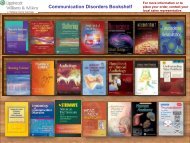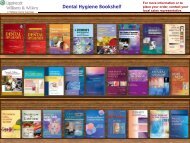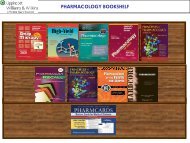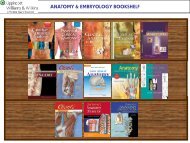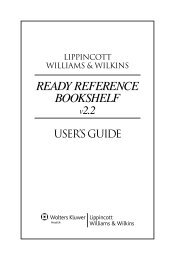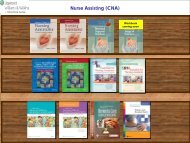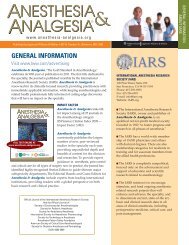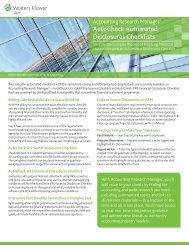Massage Therapy Bookshelf - Lippincott Williams & Wilkins
Massage Therapy Bookshelf - Lippincott Williams & Wilkins
Massage Therapy Bookshelf - Lippincott Williams & Wilkins
- No tags were found...
You also want an ePaper? Increase the reach of your titles
YUMPU automatically turns print PDFs into web optimized ePapers that Google loves.
Student Workbook for FunctionalAnatomeChristy Cael, ATC, CSCS, LMP2011/ 256 pp./ 106 illustrations/ 978-1-60913-685-7New Cover Coming SoonFeatures:The main features include the variety of exercises thatappeal to multiple learning styles:•color and label pictures matching•labeling muscle names under figureskinesthetic activities (practiced on self)•practice activities for a partner.These hands on activities in particular especially encouragelearning how to palpate bone and muscle.
Functional Anatomy Flash CardsChristy Cael, ATC, CSCS, LMPJuly 2010/ 320 illustrations/ 978-1-60913-684-0Features:•All cards are available in one comprehensive set•Artwork is repurposed from the Cael, Functional Anatomy textfor a cohesive study package•Cards are hole-punched so users can create their own studysets•Dynamic overlay art shows the relationship of surface anatomyto structures beneath the skin•Putting It in Motion cards show how the bones and muscles worktogether to complete activities of daily living
The Educated Heart: ProfessionalBoundaries for <strong>Massage</strong> Therapists,Bodyworkers, and Movement Teachers,Third EditionNina McIntosh, MSW2010/ 224 pp./ 55 illustrations/ 978-1-60547-713-8Instructor Resources:•Instructor’s Manual•Image Bank•Test Generator•PowerPoint Slides•Lesson PlansFeatures:•Color illustrations and design with several new cartoonsComplex concepts put into simple, understandable, andpractical terms for the student•Written with humor, compassion, and a non-judgmentaltone that make it engaging to students•Real-life examples illustrating common pitfalls and helpfulstrategies•Witty, light-hearted drawings illustrate key points•Helpful Glossary that efficiently defines terms andsummarizes topical issuesCase examples provide real-life scenarios of concepts andsituationsStudent Resources:•Full text online•Video Clips
Plain and Simple Guide to Therapeutic<strong>Massage</strong> & Bodywork Examinations,Second EditionLaura Allen, NCTMBJanuary 2009/ 320 pp./ 41 illustrations/ 978-0-7817-9705-4Instructor Resources:•Brownstone Test Generator•Syllabus•Lesson Plans•PowerPoint Slides: Tips for Passing•Interactive Flash Cards•Game show questions•Millionaire game questions•Labeling activities•Quiz BankStudent Resources:•Interactive Flash Cards•Game show questions•Millionaire game questions•Labeling activities•Quiz BankFeatures:•Coverage of Federation of State <strong>Massage</strong> <strong>Therapy</strong>Boards (FSMTB) exam•A least five additional review questions per chapter•Back-of-book CD-ROM contains several completepractice tests•Written in plain, simple language to put the student atease•Text is organized according to the National CertificationExamination, and each chapter is presented as an outlinereview, with end-of-chapter review questions•Positive affirmations and quotations help calm thestudents test-taking anxiety
Review for Therapeutic <strong>Massage</strong> andBodywork Certification, Third EditionJoseph Ashton, MS, PTDuke Cassel, NCTMB2010 / 336 pp./ 110 illustrations/978-1-60547-712-1Instructor Resources:•Test Generator•PowerPoint slidesStudent Resources:•Labeling exercises•Jeopardy games•Hangman games•Crossword puzzles•Electronic flashcardsFeatures:•Thorough preparation for the NCETM, NCETMB, orMBLEx exams•Test-Taking Tips help students achieve the highestscore possible•Detailed information on all the key concepts andprinciples covered on the exam, all in an easy-to-readformat•Numerous review questions cover all the main areas ofstudy, including human anatomy, physiology, andkinesiology; clinical pathology; massage therapy andbodywork; and professional standards, ethics, andbusiness practices.•Sample Practice Exam
Basic Clinical <strong>Massage</strong> <strong>Therapy</strong>:Integrating Anatomy and Treatment,Second EditionJames H. Clay, MMH, NCTMBDavid M. Pounds, Certified Medical Illustrator2006/ 443 pp./ 570 illustrations/ 978-0-7817-5677-8Instructor Resources:•Test Generator•Image Bank•PowerPoint slidesStudent Resources:•Real Bodywork DVD includesvideo demonstrations ofmassage techniques takendirectly from the bookFeatures:•Internal structure illustrations embedded into photographsshow the muscle being worked on, location on the body andattachment, manual access, problems it can cause, andbasic techniques•Technique illustration arrows show the direction of strokes•Muscles sections are broken down by: Name, Pronunciation,Etymology, Overview, Comments, Attachments, Actions,Caution, Pain Referral Zone, Other Muscles to Examine, andOne or more basic treatment techniques•Organized by body regions that have functional,topographical, and clinical coherence•Icons highlight information throughout the text: Attachments,Actions, Caution, Referral Areas, Other Muscles to Examine,Manual <strong>Therapy</strong>, and Palpation•Suggestions of draping options with illustrations•Appendices: Pain Referral Zones by Region; Greek and LatinPrefixes and Suffixes; Terms of Reference, Position, andMovement•Palpation entries included in each muscle section
Spa Bodywork: A Guide for <strong>Massage</strong>TherapistsAnne <strong>Williams</strong>2006/ 368 pp./ 330 illustrations/ 978-0-7817-5578-8Instructor Resources:•Image bank•PowerPoint slides•Curriculum Module Plans•Ready-to-Copy forms•Test Generator•Online Course•Supply Guide•Master Equipment List•Testing ModulesFeatures:•Striking full-color photographs: More than 250photographs clearly illustrate each spa technique andtreatment•Treatment Snapshots: These quick reference boxes allowthe therapist to get an overview of the treatment beforereading the step-by-step procedures section•Sanitation Boxes: Handy clean-up and sanitation tips areoffered throughout the treatment chapters•Broaden Your Understanding Boxes: These boxescontain information that helps the massage therapist tounderstand the full scope of a treatment•Sample Treatments offered at the end of chapters areeasy to add to a menu of services and come withpromotional descriptions, product recommendations,and recipes for creating inviting smell-scapes
<strong>Massage</strong> and Manual <strong>Therapy</strong> forOrthopedic Conditions, Second EditionTom Hendrickson, DCOctober 2009/ 448 pp./ 550 illustrations/ 978-0-7817-9574-6Instructor Resources:•PowerPoint Slides•Lesson Plans•Image Bank•Test Generator•Video ClipsStudent Resources:•Question Bank•Image Bank•Video ClipsFeatures:•Full color artwork•Video footage of techniques being performed•Updated Content from the author has incorporated therationale and intentions of the most important strokes,including the science of why certain approaches are used•ntroduces massage techniques for orthopedicconditions, promoting the alignment of soft tissue relatingto pain and dysfunction•Brief descriptions of rationale behind orthopedicmassage, mechanisms of injury to and repair of soft tissue,and anatomy of each body area•Detailed assessment for each body region, discussescommon lesions, and provides illustrated instructions onhow to administer this scientifically based style of massage•Based on traditional orthopedic assessment protocols,coverage includes range of motion, passive and isometrictesting, and tests that determine the severity of acondition or injury
Condition Specific <strong>Massage</strong> <strong>Therapy</strong>Celia Bucci, MA, CMTFebruary 2011/ 416 pp./ 250 illustrations/ 978-1-58255-807-3Instructor Resources:•PowerPoint Slides•Lesson Plans•Image BankStudent Resources:•Test Generator•Image Bank•Video ClipsFeatures:• Icons appear in each of the condition chapters, under“Condition-Specific <strong>Massage</strong>,” indicating treatmentgoals for the approach presented• Treatment Overview Figures in each condition chapterreinforce principles of treating musculoskeletalconditions• PROFESSIONAL GROWTH section, including Case Study,Critical Thinking Exercises engages students andbridges clinical information with student practice• Extensive art program incorporates Clay/Pounds art:some direct pickup pieces, as well as Clay/Pounds styleanatomy over fresh photos throughout the book. Artalso includes Trigger Point pieces, in which TPs + referralareas are indicated over fresh photos.
Neuromuscular <strong>Therapy</strong> ManualJocelyn Granger , Founder/Director, Ann Arbor Institute of <strong>Massage</strong> <strong>Therapy</strong>November 2010/ 400 pp./ 400 illustrations/ 978-1-58255-800-4Instructor Resources:•Image bank•Sample syllabi andlesson plans•PowerPoint slidesStudent Resources:•20 Video/DVD routines•Test Generator•Image bankFeatures:•Key terms: are listed and defined at the beginning ofeach chapter defined, boldfaced on first mention in thetext, and appear in a glossary at the end of the book.•Chapter introductions provide a brief overview of eachchapter’s contents.•Case studies discuss clients with particular pathologicalconditions and how neuromuscular therapy routines, aspresented in the text, can address them. One or twocritical thinking questions regarding the scenariopresented are included at the end of each case study.•Sample routines sections include step-by-step massageprocedures for each body region.•Chapter summaries briefly review the content covered ineach of the first four chapters.•Chapter review questions, appearing at the end of eachchapter, allow readers to test their knowledge of thecontent covered in each chapter and consist of multiplechoice, short answer, true/false, and matching.
AdvancedTreatmentTechniques forthe ManualTherapist:NeckStudent Resources:•Video ClipsAdvanced Treatment Techniques for theManual Therapist: NeckJoseph E. Muscolino, DCSeptember 2011/ 304 pp./ 395 illustrations/ 978-1-58255-850-9Features:•Chapter outline: The chapter outline serves as a roadmapof the topics and subtopics that the reader can expect tofind in the chapter.•Key terms: Key terms will appear in a list at the beginningof each chapter and will be boldface on first mention.Terms will be defined within the text.•Treatment routines: These will be a list of routines byfunctional muscle group.•Practical application box: This feature will containpractical information that will help the practitioner applythe technique. The Practical application boxes will includeall the “tip” information in one place.•Alert/Caution: an icon with a screened box that highlightsany contraindications or cautions that practitioners needto take while performing the techniques.•Think it Through: This feature will help the practitionerapply critical reasoning when assessing their clients andwill be a main feature of the text. The goal of this feature isto bridge the pathologies in Part 1 with the techniques inPart 2.
Comfort Touch: <strong>Massage</strong> for the Elderlyand the IllMary Kathleen RoseFebruary 2009/ 256 pp./ 111 illustrations/ 978-0-7817-9829-7Instructor Resources:•6-, and 16-hour Syllabus•Note to Instructors•Video Clips with Credits•Video User’s GuideStudent Resources:•Video Clips with Credits•Video User’s Guide•CARE notes with andwithout pain scales•Intake forms•Articles and reportsFeatures:•Photographs and illustrations are used throughout toclarify the text and demonstrate the techniques•Stories and examples relating to the use of Comfort Touchare included to inspire students•“Hints of Practice” and boxes provide importantinformation about the practical application of the content•Chapter Summaries highlight the most salient points ineach chapter•Questions for review are intended to guide studentstoward greater personal awareness and professionalgrowth•Glossary of key terms•An annotated bibliography details useful resources tosupport the practitioner of Comfort Touch
<strong>Massage</strong> for the Hospital Patient andMedically Frail ClientGayle MacDonald MS, LMT2004/ 224 pp./ 70 illustrations/ 978-0-7817-4705-9Features:•Portrays how massage therapy complements medicaltreatments to increase comfort, improve clinical outcomesand promote wholeness in both clients and those who carefor them•Clinical Consideration sections offer common signs,symptoms, and conditions and their impact on massagepressure adjustments, site restrictions, and positioning needs•Explains technical and medical knowledge in simplisticterms•Lays the foundation for therapists working in a medicalsetting•Presents the steps involved in planning and giving amassage session, charting, and collecting patient data•Case histories and "A Therapist Journal" offer real lifescenarios•"Teaching Tips" offer practical suggestions•Includes a historical perspective and review of hospitalmassage research•Bolded Key Terms and end of chapter "Test Yourself"exercises reinforce terms and concepts
Body Mechanics for Manual Therapists:A Functional Approach to Self-Care,Third EditionBarbara Frye, LMP, GCFPInstructor Resources:•Instructor’s Manual•Learning Exercises•Sample Syllabi•Brownstone Test Generator•PowerPoint Presentations•Image Bank•Lesson PlansStudent Resources:•Video Clips that illustrateproper technique•Full text onlineJanuary 2009/ 304 pp./ 978-0-7817-7483-3Features:•A practical, workbook-style presentation of bodymechanics•Each section begins with a narrative explanation of themovement and is followed by thought provoking exercisesand self-observation exercises•Sidebars relating chapter material are located throughoutthe text. Sidebar information includes:- Partner Practice: hands-on exercises- Self Observation: self exploration exercises- Practice Tips: self-care and injury prevention tips- Client Education tips: creative ways to impart chaptermaterial to clients- Something to Think About: provocative questions forthought and journaling- Consider This: quotes and facts that add insight•Information on successful body mechanics for spa therapy,transferring clients, and floor work•Section on common repetitive stress injuries, includingsymptom troubleshooting and pro-active strategies for injuryprevention
Hot Stone <strong>Massage</strong>: A ThreeDimensional ApproachLeslie BruderJanuary 2009/ 224 pp./ 200 illustrations/ 978-0-7817-6327-1Instructor Resources:•Image Bank•Syllabi for courses ofvarious hours•Searchable Full-TextOnlineStudent Resources:•Image Bank•Searchable Full-TextOnlineFeatures:•User-friendly, easy-to-follow manual•Unique three-dimensional approach to hot stonemassage, which involves working on both sides of thebody at once•Each chapter includes:- An outline of its contents and a bulleted list ofobjectives, and introduction, a list of key termswith definitions- Special tip and caution boxes offers remindersand easy access to important information- A summary and list of review questions at theend of each chapter to ensure that the studentcomprehends the material- Photographs that support the techniques•Special tip and caution boxes appear throughout eachchapter offering reminders and easy access to importantinformation
The Balanced Body: A Guide to DeepTissue and Neuromuscular <strong>Therapy</strong>,Third EditionDonald W. ScheumannInstructor Resources:•PowerPoint slides•5 additional case studies•Test Generator with 350questions•Image Bank•Lesson Outlines•Online CourseStudent Resources:•Interactive Atlas2006 / 272 pp./ 282 illustrations/ 978-0-7817-6308-0Features:•Case Studies with real-world scenarios and questions•Indication/Contraindication Boxes show when massageis and isn't advisable•Essential Anatomy Boxes present crucial anatomicalinformation•Cautionary Notes warn about special cases andsituations•Coverage of Trigger Point Release Work combined withdeep tissue therapy and tension release massage presentsdifferent therapeutic options•Quick Reference Charts summarize key points from theintroductory chapters•Guidelines for Elevating the Quality of <strong>Massage</strong> Workprovide suggestions to improve treatment quality•A BONUS CD-ROM packaged with this book includes 20massage technique video clips (featuring the author); 10Acland anatomy video clips; images from the text; andChapter Quizzes
Deep Tissue Sculpting: A Technical andArtistic Manual for TherapeuticBodywork Practitioners, Second EditionCarole Osborne-SheetsDistributed by LWW 2009/ /158 pp./ 978-0-9665585-2-4Features:•Instructions for over thirty deep tissue sculptingprocedures including precautions and technique hints•Three specific sessions for relieving chronic back,shoulder, and neck tension•Section on customizing treatment for clients' commoncomplaints•Tableside Technique Guide quickly outlines keyprocedures for the back, low back and abdomen, andneck and shoulders•Chapter summaries•Anatomy appendices serve as helpful tool on origin,insertion, and function for key muscles
Introduction to <strong>Massage</strong> <strong>Therapy</strong>,Second EditionMary Beth Braun, BA, CMT, NCTMBStephanie J. Simonson, BS, CMT2007/ 625 pp./ 525 illustrations/ 978-0-7817-7374-4Instructor Resources:•Image bank•PowerPoint slides•Case studies•Web links•Curriculum guideStudent Resources:•Interactive quiz tool withapproximately 300 review questions•Real Bodywork DVD includesvideo demonstrations of massagetechniques taken directly from thebookFeatures:•Progressive case studies ask you to develop step-by-steptreatment plans for a client•Procedure boxes set forth step-by-step instructions fortreatments and assessments•Exercises in each chapter help you assess your grasp ofkey concepts- New topics have been added or expanded tobetter prepare you for the National CertificationExam (NCE)- Critical thinking exercises test skills in selecting thecorrect techniques to apply under specific sets ofcircumstances- Contraindication boxes highlight particularsituations when massage should not be used or aspecific stroke may be harmful
Nurturing <strong>Massage</strong> for Pregnancy: APractical Guide to Bodywork for thePerinatal CycleLeslie Stager, RN, LMTInstructor Resources:•Full-color Image Bank•Video Clips•Syllabus for 4-, 6-, or 8-hourclass•Syllabus for 1- or 2-weekendclass•Syllabus for 3-month classStudent Resources:•Video Clips•Fully searchable text•Full-color Image Bank•Answers to chapter reviewquestionsJanuary 2009/ 256 pp./ 978-0-7817-6753-8Features:•Self-Care Tips for the Mother are practices a client can learn to relievesome of her discomforts•<strong>Massage</strong> Therapist Tips help students address or understand certainconditions•Complementary Modalities provides information about bodywork,modalities•Traditional Birth Practices highlights methods of touching used bypeople of various cultures around the world when caring for pregnant,laboring, and postpartum women•How the Partner Can Help provides ideas•Case Studies help students address concerns a practitioner may have•Dispelling Myths features common erroneous beliefs•Common complaints during pregnancy and birth are presentedalphabetically•Contraindications and Precautions icons throughout the text•Key Terms are boldfaced in the narrative and defined in the glossary•Illustrations and photographs provide students with useful visuals onhow to implement particular bodywork techniques, and offer inspirationabout pregnancy and birth•Appendices include:- A Quick Reference List of Contraindications- Resources for the Practitioner
Pre- and Perinatal <strong>Massage</strong> <strong>Therapy</strong>:A Comprehensive Practitioners' Guide toPregnancy, Labor, and Postpartum, SecondEditionCarole Osborne-SheetsFebruary, 2011/304pps/395illus/978-1-58255-850-9Features:•Chapter outline: The chapter outline serves as a roadmap of thetopics and subtopics that the reader can expect to find in thechapter.•Key terms: Key terms will appear in a list at the beginning of eachchapter and will be boldface on first mention. Terms will be definedwithin the text.•Treatment routines: These will be a list of routines by functionalmuscle group.•Practical application box: This feature will contain practicalinformation that will help the practitioner apply the technique. ThePractical application boxes will include all the "tip" information inone place.•Alert/Caution: an icon with a screened box that highlights anycontraindications or cautions that practitioners need to take whileperforming the techniques.•Think it Through: This feature will help the practitioner apply criticalreasoning when assessing their clients and will be a main feature ofthe text. The goal of this feature is to bridge the pathologies in Part 1with the techniques in Part 2.•Video will accompany the text
Hands Heal: Communication,Documentation and Insurance Billing forManual Therapists, Fourth EditionDiana L. Thompson, LMPAugust 2011/400pps/978-1-60913-387-04E Cover Coming SoonFeatures:• NEW Additional forms for practitioners• NEW Fully updated throughout to include the latest formsand insurance-related information• NEW chapter on Research and Writing Case Reports• Case studies provide examples of communication andapplication of charting techniques• Includes student quiz bank for effective review• Reader-friendly sidebars throughout the text highlight criticalinformation• Sample forms provide templates for use and correctdocumentation procedures
Hands Heal Essentials: Documentationfor <strong>Massage</strong> TherapistsDiana L. Thompson, LMPInstructor Resources:•PowerPoint slides•Instructor’s Manual•Test GeneratorStudent Resources:•Intake Forms•Treatment Notes•Quiz Bank•Quick ReferenceAbbreviation List2005 / 175 pp./ 110 illustrations/978-0-7817-5758-4Features:•Coverage of functionally-based outcomes indocumentation•SOAP charting system specific for manual therapists•Completed sample forms provide examples of correctdocumentation procedures•Information on documentation for Energy Work, On-site<strong>Massage</strong>, and Relaxation and Spa Therapies•Three sidebars:- Bone Game- Story Teller- Wise One Speaks•Three case studies: Personal Injury, Workers' Compensation,and Wellness Care•Five Appendices: Case Studies, New and Updated BlankForms, Abbreviations, ICD-9 Coding for Self-Referred Patients,and Contact Information for Workers' Compensation and forInsurance Commissioners•HIPAA regulations•Case study demonstrating charting skills for on-site massageoffers additional examples of communication andapplications of charting techniques
Therapeutic Chair <strong>Massage</strong>Ralph R. Stephens2005/ 304 pp./ 250 illustrations/ 978-0-7817-4234-4Features:•Of Special Interest boxes contain interesting buttangential information on a variety of topics•Experiential Exercises offer hands-on learning activities•Case Studies present hypothetical scenario with criticalthinking questions that challenges the reader to applyinformation to real-life situations•Clinical Tips give brief snippets of clinical advice basedon the author's experience•Contraindications list of conditions that prohibit or limitthe use of a particular stroke or technique.•Key Terms are listed and defined at the beginning ofeach chapter•Chapter summaries•Chapter Objectives
Pediatric <strong>Massage</strong> <strong>Therapy</strong>, SecondEditionMary Betts Sinclair2004/ 240 pp./ 125 illustrations/ 978-0-7817-4219-1Features:•Covers application of massage for children with specialneeds•Checklist Boxes give specific steps and further details ona key topic•Review Questions aid in self-review of material•Technique section provides step-by-step directions onperforming massage techniques•Case studies and anecdotes draw from the experienceof hands-on therapists working with children•Coverage of hydrotherapy•Over 650 references covering scientific studies andlatest research on massage therapy•Caution sections alert to possible contraindications andsituations that require special precautions•Discussion of normal growth and development inchildren•Full coverage of precautions of working with children•Table comparing adult physiological traits to children'straits and growth patterns
Anatomy and Physiology: The <strong>Massage</strong>Connection, Third EditionKalyani Premkumar, MBBS, MD, MSc, RMTFebruary 1, 2011/592pps/450illus/978-0-7817-5922-9Features:• NEW! A consistent style will be implemented with the art program to improve visualappeal• NEW! Ancillaries: for-sale study guide, thePoint instructor and student resource sites• NEW! The Third Edition will be streamlined so the content more closely aligns with atypical massage therapy A&P curriculum• Case Studies: At the end of each chapter, short case scenarios will demonstrate theapplicability of chapter content to massage practice. Each case includes applicablequestions.• <strong>Massage</strong> Connection: This section will appear at the end of each chapter. It will includea summary of how the chapter content relates specifically to massage.• Boxes:• What Ails You? These boxes will contain specific pathologies related to what a massagetherapist may encounter in their practice.Ancillary Resources:• PowerPoint slides: 25-30slides per chapter withimages from the text• Lesson plans to accompanythe text• Image Bank with labelson/labels off• Brownstone Test Generator• Table Talk: Includes short interesting facts, related to massage and anatomy• Complementary modalities: Different technique descriptions such as rolfing,acupuncture/acupressure, etc will be discussed• Assess Yourself! This box content will contain relevant activities that students can try onthemselves.• Special Features:• Surface Anatomy/Landmarks (Updated!): There will be a separate section identifyingbony and surface landmarks of the body following chapter three. All images will beplaced in one place for improved accessibility.• Muscle Tables (Updated!): This popular feature in the 2nd edition will be updated andimproved for the third edition. It will still appear following chapter 4, the MuscularSystem, but will have a new layout and new, updated images, and dynamic artworkshowing muscle overlay.
Aromatherapy for <strong>Massage</strong>PractitionersIngrid Martin AshmeadeInstructor Resources:•Lesson Plan•Image bank•PowerPoint slides•Test Generator•Online Course2006 / 336 pp./ 140 illustrations/ 978-0-7817-5345-6Features:•Case studies present specific ailments in clinicalscenarios, with proper aromatherapy and massagetreatments.•Recipe Boxes provide directions for blending a variety ofessential oils.•Activity boxes require students to apply skills and makedecisions.•Essential oil monographs provide important informationon the history and traditional uses, safety considerations,and most effective use in massage therapy of 50individual essential oils.•Review questions in every chapter test the reader'sknowledge.•Appendices include a reference of ailments and themost suitable essential oils for their treatment; a list ofrecommended essential oil suppliers; information ontraining courses in aromatherapy; and a list of suggestedjournals and Web sites
Therapeutic <strong>Massage</strong> in AthleticsPat Archer, MS, ATC, LMT2006/ 368 pp./ 400 illustrations/ 978-0-7817-4269-6Instructor Resources:•Lesson Plans•Image bank•PowerPoint slides•Test Generator•Online CourseFeatures:•Focused on the use of multiple modalities andincorporating treatment protocols for common athleticinjuries and conditions•Numerous pictures of techniques•Includes both basic and specific treatment techniques,and can therefore be used for a wide variety of coursesand educational levels•From the Field Boxes highlight quotes from professionalswho practice sports massage, and include information ontheir experiences with treating or being treated withmassage•Case Studies present a patient and his or her conditions,describing the treatment carried out and the results•Short answer style Review Questions appear at the endof each chapter•Stroke tables and anatomy diagrams provide specificguidelines and instructions•Provides techniques for the anatomy and physiology ofthe neuromuscular, fascial, and circulatory/lymphaticsystems with the rationales for how and why specifictechniques are used
Business Mastery, Fourth EditionCherie Sohnen-Moe2007/ 448 pp./ 978-0-9621265-7-4Instructor Resources:•Online Courses (36 Hourand 70 hour)•Teachers Manual•Test BankFeatures:•Business manual for massage therapists and bodyworkers•Covers the major aspects of building and maintaining asuccessful practice•Introduces practical yet innovative methods to increaseprofits, develop a strong customer base, and enhancecommunications with clients•Topics include marketing, client retention,professionalism, referrals, business planning, insurancebilling, ethics, and time-management, designingpromotional material, networking and more•Numerous charts and checklists, as well as reproduciblebusiness forms•Information on other helpful resources is provided alongwith contact information for major health careprofessional associations, business organizations andindependent living resources
The Ethics of TouchCherie M. Sohnen-MoeBen E. Benjamin PhD2004/ 310 pp./ 978-1-882908-40-0Features:•Addresses the difficult, confusing, and seldomdiscussedbut often-troubling dilemmas confrontingtouch therapy practitioners•Describes the issues, identifies clear principles, namesspecific resources, and uses stories straight from thetreatment room•Features include useful and thought-provokingactivities and exercises and real-life scenarios to intriguestudentsInstructor Resources:•Lesson Plan•COMTA•Teachers Manual
Ethics for <strong>Massage</strong> TherapistsTerrie Yardley-Nohr LMT2006/ 288 pp./ 65 illustrations/ 978-0-7817-5339-5Instructor Resources:•PowerPoint Slides•Test Generator•Image Bank•Lesson Plans•Online CourseFeatures:•Guides students through the process of putting ethicalstandards into practice, and teaches them what will beexpected of them in a professional setting•Prepares students for the multiple-choice section onethics in the National Certification Exam•Useful role-playing exercises help students build criticalthinking skills, apply knowledge, and prepare for ethicalscenarios in a work environment•Guiding information for students to think about, andexercises to help determine client expectations and howto prepare for different situations that arise in practice•Example scenarios from working massage therapistshelp younger students (who lack "life experience") tounderstand ethical dilemmas•“Industry standard" information on ethics, and assiststhem in finding ways to work within those ethicalparameters•Professional approach to subject matter
Myofascial <strong>Massage</strong>Marian Wolfe Dixon MA, NCTMB, LMT2006/ 240 pp./ 120 illustrations/ 978-0-7817-4832-2Instructor Resources:•PowerPoint Slides•Learning Objectives•Suggested TeachingStrategies•Sample Test questionsand answersFeatures:•Exquisite illustrations enhance learning andunderstanding by clarifying the techniques.•Protocol boxes recommend sequences to follow duringactual myofascial massage sessions.•Guidelines provide useful strategies for implementingeach myofascial approach and improving bodymechanics and communication skills during client sessions.•First person experiences will add to the reader's overallunderstanding of the techniques and their uses.•<strong>Massage</strong> implications, included in each anatomychapter (Chapters 2-4), help readers understand theinfluence of myofascial anatomy and physiology onpractice.•Questions for discussion and review at the end of eachchapter encourage readers to test their comprehension ofthe materials and think critically.
Modern Hydrotherapy for the <strong>Massage</strong>TherapistMary Betts Sinclair, LMT2007/ 310 pp./ 250 illustrations/ 978-0-7817-9209-7Instructor Resources:•Image bank•PowerPoint slides•Test generatorFeatures:•Current research on the physiology of hydrotherapy and itsmedical applications•Simple explanations of how hydrotherapy affects the body•Demonstrations of many different hydrotherapy treatments•Suggestions for using hydrotherapy treatments before, duringor after massage sessions.•Discussion of how to use hydrotherapy treatments for stressreduction and for a wide variety of injuries and chronicconditions. Examples and case studies are drawn from realtherapists with real clients.•Directions for both you and your clients on how to usehydrotherapy treatments for self-care, and handouts forclients that explain how they can do the treatments at home.•Specific adjuncts that may be used with hydrotherapytreatments, such as essential oils, salts and herbs.•Explanations of how to locate and use hard-to-findhydrotherapy equipment
Drug Handbook for <strong>Massage</strong> TherapistsJean M. Wible, RN, BSN, NCTMB, CHTPApril 2008/ 592 pp./ 657 Tables/ 978-0-7817-6309-7Student Resources:•Animations of drugabsorption, drugdistribution, drug binding,and drug excretion•Appendix•Glossary•Author biographyFeatures:•Alphabetical, quick reference format•Over 650 drugs listed•Introductory section offers a series of questions to beanswered based on deductive reasoning that is adaptablefor clients taking one or many drugs•Covers medications regulated by the FDA as prescription orover-the-counter drugs•Drug entry includes:- Generic name- Pronunciation guide- Brand or trade names- Drug class- Drug actions (effects on the body)- Use (listing of disease, disorders, or symptoms thedrug would be used to treat)- Side effects (unwanted or undesirable effectsof the drug)•Tables include:- Onset- Peak- Duration- <strong>Massage</strong> contraindications
Pharmacology for <strong>Massage</strong> <strong>Therapy</strong>Jean M. Wible RN, BSN, NCTMB, CHTPInstructor Resources:•Image bank•PowerPoint slides•Test Generator2004 / 320 pp./ 75 illustrations/ 978-0-7817-4798-1Features:•Standard format for each drug classification including:- <strong>Massage</strong> implications and assessment- Pharmacokinetics- Pharmacodynamics- Pharmacotherapeutics- Adverse reactions/warnings in pronounced "Side Effect"boxes- Commonly used drug names•A basic introduction to pharmacology and massageincluding drug effects on massage, cautions, andcontraindications•<strong>Massage</strong> Implications and Assessment sections discuss theeffect of the drugs, the changes that may be needed inapplying massage, contraindications, and the effects ofadverse reactions•Detailed Case Studies apply information in real-worldscenarios•Adverse Reactions outline the most common side effectsand adverse reactions•A Drug Index offers a convenient reference•<strong>Massage</strong> therapy drug assessment form•Domestic and Canadian drugs arranged by classification
A <strong>Massage</strong> Therapist’s Guide toBusinessLaura Allen, NCTMBJanuary 2011/ 304 pp./ 65 illus./ 978-1-58255-827-1Instructor Resources:• Lesson Plans• PowerPoint Slides• Image Bank• Sample Forms• Test Bank/GeneratorFeatures:• There are several “driving” themed features; together withthe design of the book, these emphasize the idea that thestudent/practitioner is on a journey, and is in control:• "Roadside Assistance" (advice from the author)• "Words of Wisdom" (1- or 2-sentence bits of generaladvice from author)• "Alternate Routes" (advice for non-entrepreneurs)• “Explorations” (boxed feature that prompts studentsto research specific issues in their communities)• “My Personal Journey” (journaling page to plan,consider obstacles, etc., with blanks for students towrite on directly)• In addition to the “businesslike” forms, letters, and othersamples, the book includes humorous cartoons• Chapter opening quote to inspire and set the tone forchapter• Key Concepts (learning objectives) listed on chapteropener• Glossary of key terms and definitions (end of book)
One Year to a Successful <strong>Massage</strong><strong>Therapy</strong> PracticeLaura Allen, NCTMB2008/ 220 pp./ 978-0-7817-7120-7Features:•Inspirational Quotations about success•Personal anecdotes from successful massage therapists•An end of chapter journal outlining the week's goals,actions, and progress•Each chapter is a new, pro-active task•Each chapter represents one week in a yearInstructor Resources:•PowerPoint slides•Lesson plans•Handouts•Template of a tri-fold brochure•Sample business cardStudent Resources:•Templates and handouts:- Sample intake form- Payment plan agreement- Business plan
Outcome-Based <strong>Massage</strong>: FromEvidence to Practice, Second EditionCarla-Krystin Andrade PhD, RPTPaul Clifford BSc, RMTFebruary 2008/ 576 pp./ 267 illustrations/ 978-0-7817-6760-6Instructor Resources:•PowerPoint Presentations•Curriculum Guides offeringcustomized sequences ofchapters topics for programsof different lengths and levels•Test Generator•Image CollectionStudent Resources:•Video Clips of techniquesand key concepts•Full Text Online•Student Quiz BankFeatures:•Content and material addresses licensure and credentialingrequirements•Material is relevant to National Certification Examination forTherapeutic <strong>Massage</strong> and Bodywork pathology/the AmericanPhysical <strong>Therapy</strong> Association Required Skills of Physical<strong>Therapy</strong> Graduates examination•Step-by-step instructions guide how to select, sequence, andperform 17 most commonly used massage techniques•Integrates a wide variety of techniques into a singleproblem-solving format consistent with the APTA's "Guide toPhysical Therapist Practice"•Case studies and critical thinking questions illustrateapplications of theoretical concepts to basic and complexclinical cases, and more•Presents Evidence to Practice and Theory to Practicesequences•Interpersonal aspects of massage in clinical care, includingthe client-clinician relationship, ethical issues, and the client'semotional response to treatment•Separation of Basic and Advanced Content
The Psychology of the BodyElliot Greene, MA, NCTMBBarbara Goodrich-Dunn2003/ 365 pp./ 130 illustrations/ 978-0-7817-3782-1Features:•Provides massage therapists and bodyworkers with agreater understanding of the psychological issues thatcan arise from using touch in their therapy sessions•Describes the connection between the body and themind, how touch affects this connection, the client'semotional reaction and release, and how to respond tothe client in an appropriate manner•Clearly defines the scope of practice in this area formassage therapists, and bodyworkersInstructor Resources:•Instructor’s Manual
Memmler’s The Human Body in Healthand Disease, Eleventh EditionBarbara Janson Cohen BA, MSEdInstructor Resources:•LiveAdvise Online Teaching Advice•Lesson Plans•Instructor’s Manual•Image Bank•Teaching Strategies•Answers to Questions for Study andReview•Health Professions Career Information•PowerPoints with Images•Test GeneratorStudent Resources:•LiveAdvise Tutoring•PASSport to Success•Audio Glossary•Health Professions Career Information•Tips for Effective Studying2008/617 pp./470 illus./Soft Cover:978-0-7817-9073-4/Hard Cover:978-0-7817-6577-0Features:•Revised art and design helps engage students to easily learn A&P•Real dissection photographs from Rohen’s Color Atlas of Anatomy•Icons point students to activities on the CD or companion Website•New Case Scenarios integrated throughout each chapter showsstudents how content is applied to real-life situations•Feature boxes include:- Disease in Context boxes- Career Information boxes- Clinical Perspectives- Hot Topics boxes- Health Maintenance boxesWord Anatomy sections at the end of each chapter•Various end-of-chapter questions assist students in test recall,concept comprehension, and critical thinking•Checkpoint questions throughout each chapter help studentsreview key points•“Zooming In” questions test student understanding of particularillustrations•Appendices- Metric Measurements- Common Lab Tests- Temperature Conversion Scale- Periodic Tables of Elements- Typical Diseases with their Causes
Study Guide to AccompanyMemmler’s The Human Body in Healthand Disease, Eleventh EditionBarbara Janson Cohen BA, MSEdKerry L. Hull2008/416 pp./200 illus./978-0-7817-6581-7Instructor Resources:•Answers to Study Guideare in the Instructor’sManual that accompaniesthe textStudent Resources:•Health Professions CareerInformation•Tips for Effective StudyingFeatures:•Chapter overviews•Writing exercises•Coloring and labeling exercises•Concept maps•Practical application scenarios•Matching exercises•Short-essay questions•Multiple-choice, fill-in-the-blank, and true-false questions•Updates on current research trials and applications•Information on real-life anatomy and physiology inaction
Memmler’s Structure and Function of theHuman Body, Eighth EditionBarbara Janson Cohen BA, MSEdJason TaylorInstructor Resources:•LiveAdvise Online Teaching Advice•Lesson Plans•Instructor’s Manual•Image Bank•Teaching Strategies•Answers to Questions for Study &Review•Health Professions Career Information•PowerPoints with Images•Test GeneratorStudent Resources:•LiveAdvise Tutoring•PASSport to Success•Audio Glossary•Health Professions Career Information•Tips for Effective Studying2008/471 pp./289 illus./Soft Cover:978-0-7817-6595-4/ Hard Cover:978-0-7817-6588-6Features:•Revised art and design helps engage students to easily learn A&P•Real dissection photographs from Rohen’s Color Atlas of Anatomy•Icons point students to activities on the CD or companion Website•New Case Scenarios integrated throughout each chapter showsstudents how content is applied to real-life situations•Feature boxes include:- A&P in Action boxes- A&P in Action Revisited boxes- Career Information boxes- Hot Topics boxes- Health Maintenance boxes- A Closer Look boxes•Word Anatomy sections at the end of each chapter•Various end-of-chapter questions assist students in test recall, conceptcomprehension, and critical thinking•Checkpoint questions throughout each chapter help students reviewkey points•“Zooming In” questions test student understanding of particularillustrations•Outline summaries at the end of each chapter•Appendices- Metric Measurements- Temperature Conversion Scale- Periodic Tables of Elements
Memmler’s Structure and Function of theHuman Body, Eighth EditionBarbara Janson Cohen BA, MSEdKerry L. Hull2005/352 pp./200 illus./978-0-7817-5185-8Instructor Resources:•Answers to Study Guideare in the Instructor’sManual that accompaniesthe textStudent Resources:•Health Professions CareerInformation•Tips for Effective StudyingFeatures:•Chapter overviews•Writing exercises•Coloring and labeling exercises•Concept maps•Practical application scenarios•Matching exercises•Short-essay questions•Multiple-choice, fill-in-the-blank, and true-false questions•Updates on current research trials and applications•Information on real-life anatomy and physiology inaction
Stedman’s Medical Dictionary for theHealth Professions and Nursing,Seventh EditionStedman’s2011/ 2512 pp./ 1000 illus./ 978-1-60831-692-2Ancillary Assets:• More than 40,000pronunciations online• 5,600 illustrationsavailable onlineFeatures:• Over 56,000 terms• Nearly 65 valuable appendices• 1,000 illustrations• Anatomical insert by Anatomical Chart Company• Written pronunciations for every term• British alternative spellings• Precision-cut thumb tabs• A to Z organization for easier look up• Over 70 leading consultants from the fastest growingnursing and health professions contributed to theenhancements of this latest edition• FREE One year subscription to Stedman’s Online• FREE version of Stedman’s PLUS Medical/PharmaceuticalSpellchecker ($99 value)
Coloring Atlas of the Human BodyKerry Hull, PhDFebruary 2009/ 248 pp./ 250 illus./ 978-0-7817-6530-5Student Resources:•Bonus study andtest taking tips•Additional coloringexercisesFeatures:•Follows a Systems Approach so it can be used with anytraditional Anatomy and Physiology text•Introductory chapter summarizes fundamental concepts inanatomy, cell biology, histology, and microbiology•Coloring plates consist of a narrative page and a figurepage•Accompanying flashcards located at the back of the bookto assist students who have trouble remembering difficultcontent
LWW’s Student Success for HealthProfessions Made Incredibly Easy,Second Edtiion<strong>Lippincott</strong> <strong>Williams</strong> & <strong>Wilkins</strong>February 2011/ 326 pp./ 173 illustrations/ 978-1-60913-784-7Instructor Resources:•Test Bank•Syllabi for 8-week, 10-week, and16-week courses•PowerPoint presentations•Strategies for effective teaching•Chapter-specific teaching tips•WebCT/BB/Angel coursecartridgesStudent Resources:•Learning styles assessment•Self-Paced Online Course•“Playing for Real” narratives•Printable planner pages•Sample cover letters andresumes•Career resource linksFeatures:• Revised and updated with a more user-friendly organizationand design, but retains the health professions focus, theconcise and approachable narrative, and the fun featuresand art.• The first and only student success text designed specificallyfor health professions students and programs!•Self-Paced Online Course with activities and a final exam• Winning Strategy Lists set forth the objectives for the chapter• Playing for Real Scenarios: show students how content isapplied to real-life situations in the classroom and in clinicalpractice• Tips from the Pros offer expert advice and proven strategiesfor overcoming study and test-taking problems• The Finish Line Summaries highlight the key concepts andskills that students need to master• Keeping Score Questions and Activities challenge studentsto consider how they will apply the content
Communication Skills for the HealthProfessionalLaurie Kelly McCorry, PhDJeff MasonFebruary 2011/ 256 pp./ 50 illus./ 978-1-58255-814-1Features:• Presents the fundamentals of communication skills gearedspecifically for students in the allied health professions• Includes a clear, concise presentation of the principles ofcommunication theory as well as verbal and nonverbalcommunication• Instructs the health care professional on communicating withpatients whose ability may be impacted by anxiety, culturaldifferences, language differences and other situations.• Organized into three main sections outlining basic communicationprinciples and their uses in clinical and administrative settings• Chapters on cultural sensitivity, adapting communication to adjustto a patient’s ability to understand, and dealing with other roadblocksprovide students with techniques to handle many situations that theywill encounter as a healthcare professional.• Role Play boxes interspersed throughout the chapters teach studentshow to work through various scenarios that they may encounter inpractice.• Clinical applications, included in each chapter, offer more complexscenarios to aid the students in developing the critical thinking skillsthey will need to apply in practice.
Stedman’s Pocket Guide to MedicalLanguageStedman’sOctober 2008 / 352 pp./ 25 illus./ 978-0-7817-9981-2Ancillary Asset:•Bonus CD-ROM includes:- Image Bank- Audio Pronunciationdrills- Spanish-Englishpronunciation glossaryFeatures:•Portable reference•16-page full-color anatomy atlas•Full-color design with printed tabs to quickly orient thereader•Quick reference lists•Quick reference tables•Spanish-English content•Audio pronunciations on CD-ROM including Spanish•Image Bank•Dedicated sections focus on commonly confusedterminology (including drug names), abbreviations,acronyms, and symbols
Step by Step<strong>Massage</strong> <strong>Therapy</strong>Protocols CoverComing SoonStep By Step <strong>Massage</strong> <strong>Therapy</strong> Protocolsfor Common Conditions:LWW <strong>Massage</strong> <strong>Therapy</strong> and BodyworkEducational SeriesCharlotte Michael VersagiAugust 15, 2011/352pps/65illus./978-0-7817-8715-4No features available


